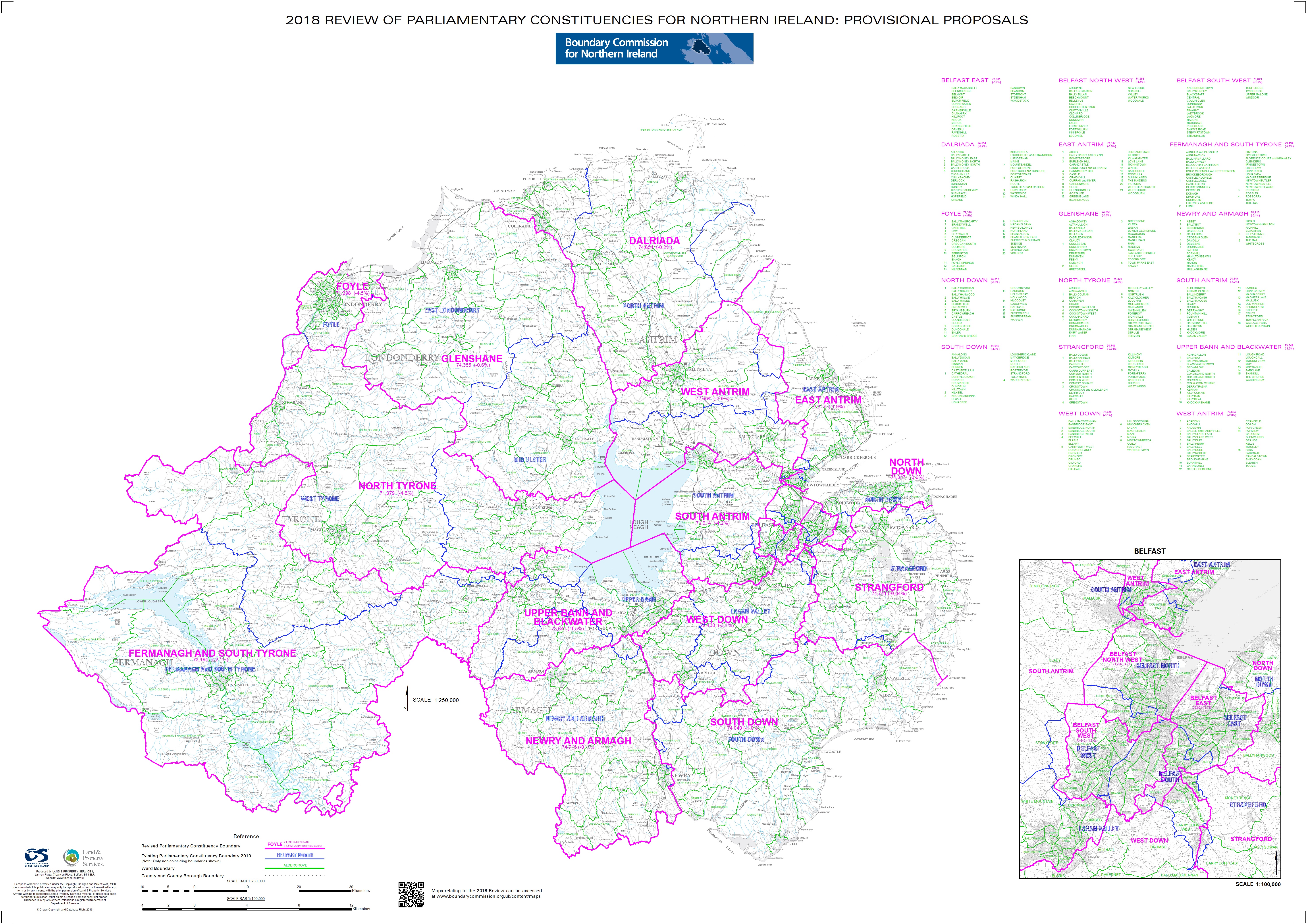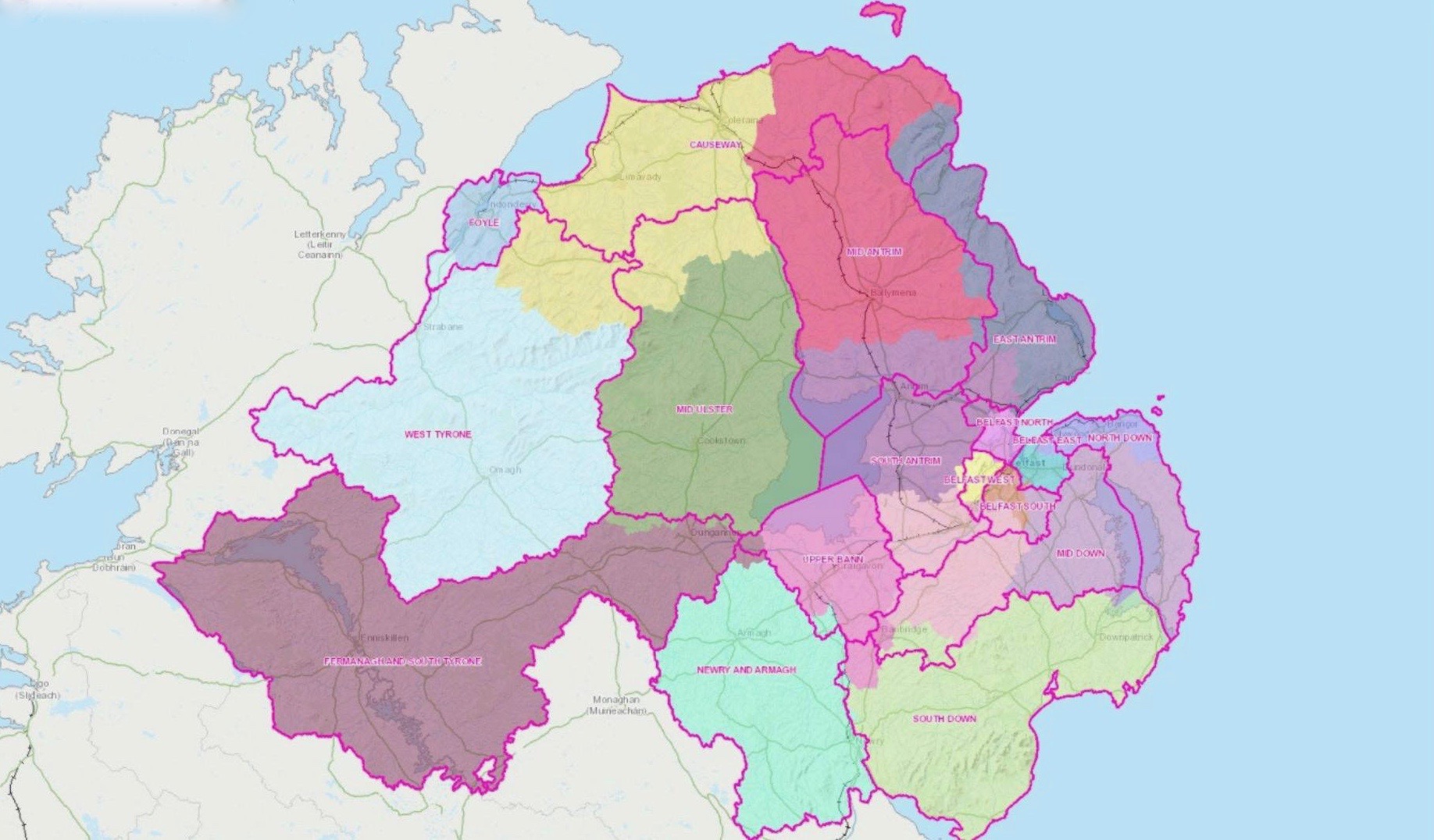The latest proposals for Northern Ireland’s constituency boundaries were accidentally revealed earlier this week when an eagle-eyed reporter for the Press Association noticed they had been published on the Boundary Commission’s website. The Boundary Commission has since removed the map claiming that its publication was in error. Yet the map has already lead to accusations of gerrymandering – a particularly loaded term given Northern Ireland’s history. Is this hyperbole or is there something more to it?
The map was published as part of an ongoing review of Northern Ireland’s boundaries – a review that is mostly focussed on reducing Northern Ireland’s representation at Westminster from 18 MPs to 17. The previous recommendations – published in 2016 – were controversial, as is the whole suggestion that Northern Ireland’s representation should be reduced. Nevertheless, the 2016 suggestions were radical, as you can see:

The 2016 recommendations would have seen a complete overhaul of Northern Ireland’s constituencies with few constituencies keeping the same name, let alone the same shape. Those recommendations would have seen Belfast’s four seats reduced to three whilst Upper Bann, East Londonderry, Mid Ulster and Lagan Valley would have been changed beyond recognition. Politically speaking, this was explosive – particularly when one study calculated that had these boundaries been used in 2017, the DUP would only have won seven seats with Sinn Féin winning nine in comparison.
The DUP subsequently rejected the proposals and called for changes when the recommendations were reviewed. Today, we finally saw the Boundary Commission’s response to those criticisms and you can see the new map:

These recommendations represent something of a halfway house between what we have now and the 2016 recommendations. Belfast is keeping four constituencies and many more constituencies are retaining their names with only minor alterations. The main changes are on the north coast and the suburban constituencies around Belfast. So what will this mean for the parties?
Looking at Westminster this is pretty good news for both Sinn Féin and the DUP. Almost all of Sinn Féin’s current seats face very little by way of alterations and they are likely to hold on to all seven. The DUP meanwhile will technically lose one (as there is one fewer seat) but are likely to make up for that with the addition of the Ards Peninsula to North Down – a decision that will add many new DUP voters to the constituency.
Yet Sinn Féin have been quick to accuse the DUP and the Conservative government of gerrymandering. To understand why they think this we need to look at the likely impact all this would have on Assembly elections. One less constituency means five fewer MLAs in total and with only one MLA separating the DUP and Sinn Féin, and indeed Unionism from Nationalism, it is natural that all parties would be concerned.
With that in mind here’s what I think the assembly could look like if these proposals were carried out, based on the 2017 General Election results:
| SF | SDLP | Alliance | UUP | DUP | Other | |
| Causeway | 1 | 1 | – | – | 3 | – |
| East Antrim | – | – | 1 | 1 | 3 | – |
| East Belfast | – | – | 2 | – | 3 | – |
| Fermangh & South Tyrone | 3 | – | – | – | 2 | – |
| Foyle | 2 | 2 | – | – | 1 | – |
| Mid Antrim | 1 | – | – | 1 | 3 | – |
| Mid Down | – | – | 1 | 1 | 3 | – |
| Mid Ulster | 3 | 1 | – | – | 1 | – |
| Newry & Armagh | 3 | 1 | – | – | 1 | – |
| North Belfast | 2 | 1 | – | – | 2 | – |
| North Down | – | – | 1 | 1 | 3 | – |
| South Antrim | – | – | 1 | 1 | 3 | – |
| South Belfast | 1 | 1 | 1 | – | 2 | – |
| South Down | 2 | 2 | – | – | 1 | – |
| Upper Bann | 1 | 1 | – | 1 | 2 | – |
| West Belfast | 4 | – | – | – | – | 1 (PBP) |
| West Tyrone | 3 | 1 | – | – | 1 | – |
| TOTAL | 26 (-1) | 11 (-1) | 7 (-1) | 6 (-4) | 34 (+6) | 1 (-4) |
Naturally this is all open to debate and none of this is certain. Voting patterns at general elections are different from Assembly elections; the campaign itself matters and candidates themselves can change outcomes. But here are the calculations that have led me to this result:
- Sinn Féin will lose a seat from the changes to East Londonderry/North Antrim/South Antrim.
- The SDLP will lose a seat from the changes to South Antrim/Lagan Valley.
- The Greens will struggle in both the new North Down and the new South Belfast.
- Claire Sugden will have to campaign in parts of North Antrim where the other parties are already organised and Jim Allister will struggle due to the splitting of his core vote.
- The DUP will defeat sitting UUP MLAs representing East Antrim, Belfast East, and Fermanagh and South Tyrone – the general election result make this likely no matter what the boundaries!
- Alliance and the UUP will lose one seat each purely through the reduction in constituencies.
None of this is certain – far from it. But this is certainly a different outcome to the one the 2016 recommendations implied. One can see why nationalists might be upset and why unionists, particularly the DUP, would be pleased by it. Unionism currently sits on a combined total of 40/90 – this result would put them on 40/85 whilst nationalist representation slips from 39/90 to 37/85.
Is this by design? It certainly appears to be a be as good as the DUP could have hoped for – if one accepts that Northern Ireland has to lose a seat. It’ll be well worth seeing the reaction to this over the coming days and to see if the DUP’s demands for the boundary review to be scrapped are quietly dropped.
Also published on Medium.
